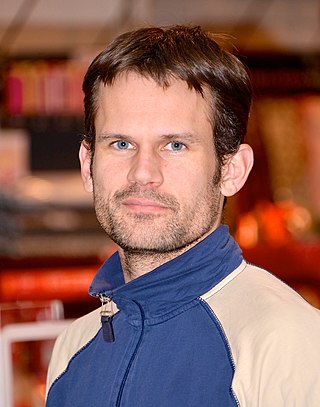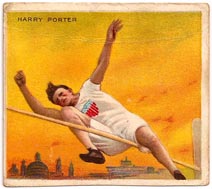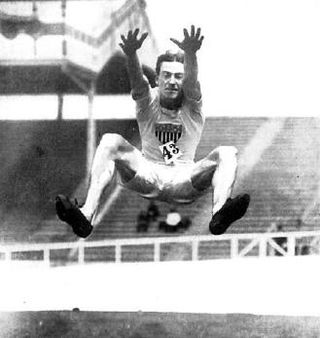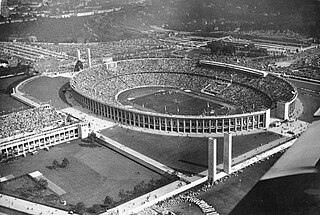
The men's high jump competition at the 2004 Summer Olympics in Athens was held at the Olympic Stadium on 20–22 August. Thirty-eight athletes from 27 nations competed. The event was won by Stefan Holm of Sweden, the nation's first victory in the men's high jump and first medal in the event since Patrik Sjöberg won three in a row from 1984 to 1992. Matt Hemingway took silver, returning the United States to the podium after a one-Games absence. Jaroslav Bába's bronze was the first medal in the event for the Czech Republic.

The men's high jump was a track & field athletics event at the 1900 Summer Olympics in Paris. It was held on July 15, 1900. Eight athletes from seven nations competed in the high jump. The event was won by Irving Baxter of the United States, the nation's second consecutive victory in the men's high jump. Great Britain and Hungary each took medals in their first appearance in the event.

The men's high jump was one of six jumping events on the athletics at the 1908 Summer Olympics programme in London. The competition was held on Tuesday, July 21, 1908. Twenty-two high jumpers from ten nations competed. NOCs could enter up to 12 athletes. The event was won by Harry Porter of the United States, the nation's fourth consecutive victory in the men's high jump. There was a three-way tie for silver.

The men's long jump was one of six jumping events on the Athletics at the 1908 Summer Olympics programme in London. The competition was held on July 22, 1908. Thirty-two athletes from 9 nations competed. NOCs could enter up to 12 athletes. The event was won by Frank Irons of the United States, the nation's fourth consecutive victory in the first four Olympic Games. Calvin Bricker of Canada took bronze to break up the Americans' attempt at another sweep.
The men's pole vault was one of six jumping events on the athletics at the 1908 Summer Olympics programme in London. The competition was held on Friday, July 24, 1908. 15 pole vaulters from seven nations competed. It is the only one of the 111 events featured in 1908 to not have any competitors from the host nation. NOCs could enter up to 12 athletes. The event was won by Edward Cook and Alfred Carlton Gilbert of the United States, the nation's fourth consecutive victory in the men's pole vault. The tie was permitted, rather than a jump-off being held, due to the length of the competition. Similarly, bronze medals were awarded to all three men who had cleared 3.58 metres for third place. Sweden and Canada thus received their first medals in the pole vault, while the United States had the unusual distinction of winning three medals in an event but not sweeping.
Lajos Gönczy was a Hungarian high jumper. He participated in Athletics at the 1900 Summer Olympics in Paris, the 1904 Summer Olympics in St. Louis and the 1906 Intercalated Games in Athens and won two medals.
Paul Weinstein was a German athlete who competed in the early twentieth century. He was born in Wallendorf.

The men's pole vault was a track and field athletics event held as part of the Athletics at the 1904 Summer Olympics programme. It was the third time the event was held. Seven pole vaulters from two nations participated. The competition was held on Saturday, September 3, 1904. The event was won by Charles Dvorak of the United States, the nation's third consecutive victory in the event. With six of the seven vaulters, the United States swept the top three places—the first time that occurred in the pole vault, though the Americans had never had more than two vaulters compete previously. Through the 1904 Games, no American pole vaulter had ever placed lower than any non-American vaulter.
The men's high jump competition at the 1988 Summer Olympics in Seoul, South Korea had an entry list of 27 competitors from 18 nations, with two qualifying groups before the final (16) took place on Sunday September 25, 1988. The maximum number of athletes per nation had been set at 3 since the 1930 Olympic Congress. There were two bronze medals awarded. The event was won by Hennadiy Avdyeyenko of the Soviet Union, the nation's first victory in the men's high jump since 1972 and fourth overall. Hollis Conway's silver returned the United States to the podium after a two-Games absence that had disrupted the American streak of medaling in every Olympic men's high jump. Patrik Sjöberg's bronze made Sweden the fourth nation to medal in two consecutive Games, after the United States, the Soviet Union, and France. The other bronze medal went to Rudolf Povarnitsyn of the Soviet Union after the countback could not break the tie for third.

The men's high jump, also known as the running high jump to distinguish it from the standing high jump, was a track and field athletics event held as part of the Athletics at the 1912 Summer Olympics programme. It was the fifth appearance of the event, which is one of 12 to have been held at every Summer Olympics. The competition was held on July 7, 1912, and on July 8, 1912. Thirty-seven high jumpers from ten nations competed. NOCs could enter up to 12 athletes. The event was won by Alma Richards of the United States, the nation's fifth consecutive victory in the men's high jump. Germany won its second silver medal in the event, after 1904.

The men's high jump was an event at the 1956 Summer Olympics in Melbourne, Australia. Twenty-eight contestants from 19 nations met on the morning of the first day of the athletic contests, on Friday November 23, 1956, and 22 cleared the qualifying height of 1.92 metres, to meet again in the afternoon. The maximum number of athletes per nation had been set at 3 since the 1930 Olympic Congress. The event was won by Charles Dumas of the United States, the nation's second consecutive and 11th overall victory in the men's high jump. Chilla Porter's silver was Australia's second medal in the event. Igor Kashkarov's bronze was the Soviet Union's first.

The men's pole vault event was part of the track and field athletics programme at the 1920 Summer Olympics. The competition was held on Wednesday, August 18, 1920, and on Friday, August 20, 1920. 16 pole vaulters from seven nations competed. No nation had more than 4 jumpers, suggesting the limit had been reduced from the 12 maximum in force in 1908 and 1912. The event was won by Frank Foss of the United States, the nation's sixth consecutive victory in the men's pole vault. Henry Petersen's silver was Denmark's first medal in the event and the first time a non-American had done better than bronze in the pole vault. Edwin Myers's bronze continued the American streak of winning at least two medals in each pole vault, however.
The men's high jump was an event at the 1992 Summer Olympics in Barcelona, Spain. There were 43 participating athletes from 27 nations. The maximum number of athletes per nation had been set at 3 since the 1930 Olympic Congress. The qualification mark was set at 2.29 metres. The event was won by Javier Sotomayor of Cuba, the nation's first victory in the men's high jump. Patrik Sjöberg of Sweden earned silver, becoming the first man to win a third medal in the event, though he never won gold. Sweden was only the third country to have three consecutive podium appearances. A three-way tie for third could not be resolved by countback, so bronze medals were awarded to Tim Forsyth, Artur Partyka, and Hollis Conway.

The men's high jump event was part of the track and field athletics programme at the 1924 Summer Olympics. The competition was held from Sunday, July 6, 1924, and Monday, July 7, 1924. Twenty-seven high jumpers from 17 nations competed. The maximum number of athletes per nation was 4. The event was won by Harold Osborn of the United States, the nation's seventh consecutive victory in the men's high jump. As in 1920, the Americans went 1–2 in the event, with Leroy Brown earning silver. France took its first high jump medal since 1908 with Pierre Lewden's bronze.

The men's high jump event at the 1980 Summer Olympics in Moscow, Soviet Union had an entry list of 30 competitors from 19 nations. The maximum number of athletes per nation had been set at 3 since the 1930 Olympic Congress. The final was held on Friday 1 August 1980. The event was won by Gerd Wessig of East Germany, the first gold medal by a German athlete in the men's high jump. It was also the first time a world record in the high jump had been set at the Olympics. Jörg Freimuth took bronze, making East Germany the third nation to have two medalists in the event in the same Games. Defending champion Jacek Wszoła of Poland took silver, becoming the fourth man to win two high jump medals and matching Valeriy Brumel for best results at one gold and one silver. Through the 2016 Games, Wszoła, Brumel, and Javier Sotomayor remain the most successful Olympic men's high jumpers; no high jumper has won two gold medals, or one gold and two silvers. Due at least in part to the American-led boycott, the United States' streak of making the podium in every Olympic men's high jump event to date ended, though a strong field may have kept them out of the medals even if they had competed.

The men's high jump event at the 2000 Summer Olympics as part of the athletics program was held at the Olympic Stadium on Friday, 22 September and Sunday, 24 September. Thirty-five athletes from 24 nations competed. The maximum number of athletes per nation had been set at 3 since the 1930 Olympic Congress. The high jump has been ever present since the beginning of the modern Olympic Games in 1896. The event was won by Sergey Klyugin of Russia, the nation's first medal and victory in the men's high jump in the nation's first appearance after the breakup of the Soviet Union. Javier Sotomayor of Cuba was the eighth man to win a second medal in the event ; he joined Valeriy Brumel and Jacek Wszoła as the most successful Olympic high jumpers in history with a gold and a silver—despite missing the 1984 and 1988 Games due to boycott and being hampered by injury in 1996. Abderrahmane Hammad's bronze was Algeria's first medal in the men's high jump.

The men's high jump event at the 1928 Olympic Games took place July 29. Thirty-five athletes from 17 nations competed. The maximum number of athletes per nation was 4. Bob King won the final with a jump of 1.94 metres. Four other competitors cleared 1.91 metres, and their placement was decided via a jump-off. King's victory was the United States' eighth consecutive victory in the men's high jump; Benjamin Hedges's silver made it the third straight Games in which Americans went 1–2. Claude Ménard earned France's second consecutive bronze medal in the event.

The men's high jump event at the 1932 Olympic Games took place July 31. It was a final only format, no heats or qualifying jumps. Fourteen athletes from 10 nations competed. The 1930 Olympic Congress in Berlin had reduced the limit from 4 athletes per NOC to 3 athletes. The event was won by Duncan McNaughton of Canada, breaking the United States' dominance over the event; McNaughton was the first non-American to win. Bob Van Osdel of the United States took silver, while Simeon Toribio earned the Philippines' first medal in any track & field athletics event.

The men's high jump event was part of the track and field athletics programme at the 1936 Summer Olympics. The competition was held on August 2, 1936. Forty athletes from 24 nations competed. The maximum number of athletes per nation had been set at 3 since the 1930 Olympic Congress. The final was won by Cornelius Johnson of the United States. It was the nation's ninth victory in the men's high jump. Johnson's fellow Americans Dave Albritton and Delos Thurber took silver and bronze to complete the podium sweep, the second time the United States had taken all three medals in the event.

The men's high jump competition at the 2012 Summer Olympics in London, United Kingdom was held at the Olympic Stadium on 5–7 August. Thirty-five athletes from 27 nations competed. The event was won by Ivan Ukhov of Russia, the nation's second consecutive and third overall victory in the men's high jump. On February 1, 2019, Ukhov was stripped of the gold medal by the Court of Arbitration in Sport for doping offenses. Erik Kynard's silver returned the United States to the men's high jump podium after a one-Games absence. A three-way tie for third resulted in bronze medals for Derek Drouin, Robert Grabarz, and Mutaz Essa Barshim. In 2021, the medals were reallocated; Kynard received the gold medal, while Drouin, Grabarz and Barshim were all promoted to the silver.















